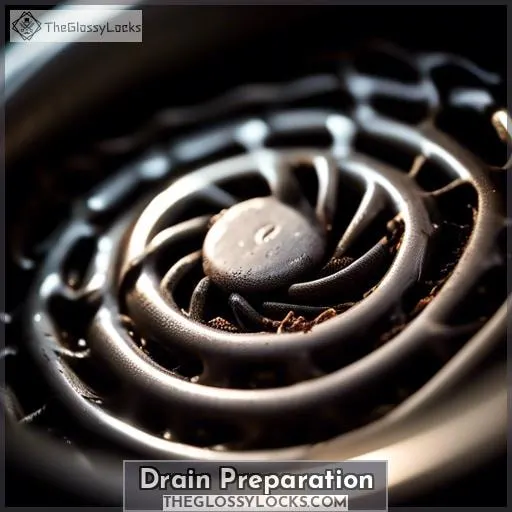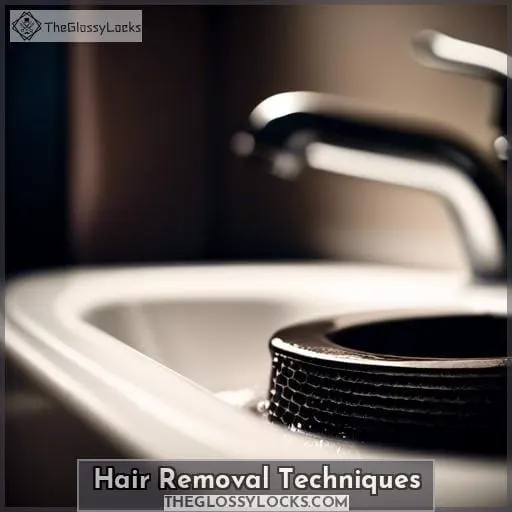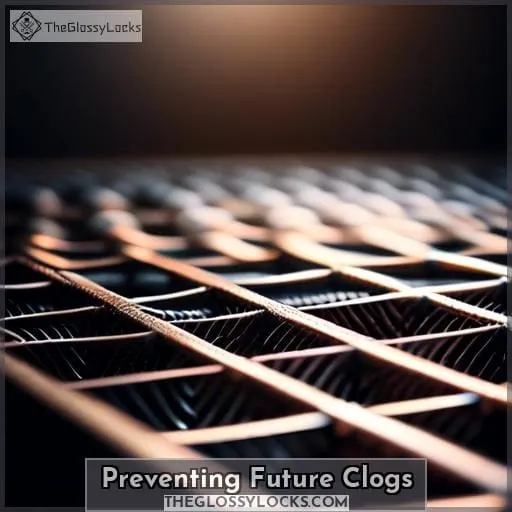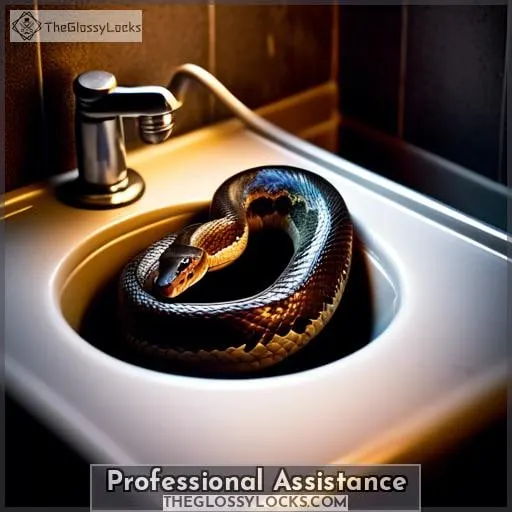This site is supported by our readers. We may earn a commission, at no cost to you, if you purchase through links.

From simple household items like baking soda and vinegar to handy tools like a drain snake, these methods are practical and easy to implement.
Plus, we’ll share tips on preventing future clogs, so you can enjoy a hassle-free bathroom experience.
Yes, you can get hair out of your drain by using a combination of baking soda and vinegar, tweezers, a snaking device, or by removing the drain.
Table Of Contents
- Key Takeaways
- Drain Preparation
- Hair Removal Techniques
- Preventing Future Clogs
- Addressing Common Concerns
- Professional Assistance
- Frequently Asked Questions (FAQs)
- Can hair clogs damage the pipes over time, and if so, how?
- Are there any environmental concerns associated with flushing hair down the drain?
- How does hard water affect the likelihood of hair clogs forming in drains?
- Can certain types of hair, like animal fur or synthetic hair from wigs, cause more severe clogs than human hair?
- Are there any home remedies for hair clogs that are safe for septic systems?
- Conclusion
Key Takeaways
- Use a combination of baking soda and vinegar to create a reaction that helps eliminate hair clogs. This method is effective and environmentally friendly, avoiding the use of harsh chemicals that can damage plumbing.
- Physical removal of hair using tools like tweezers or needle-nose pliers can be effective, especially when the clog is near the drain’s surface. This method allows for direct removal of hair without the need for chemicals.
- Installing a hair catcher in drains can significantly reduce the risk of future clogs by trapping hair before it enters the plumbing system. This preventive measure is simple yet highly effective.
- For severe or deep clogs, professional drain cleaning services offer a comprehensive solution. Professionals have the tools, technology, and expertise to effectively remove clogs, ensuring proper drainage and preventing potential damage to pipes.
Drain Preparation
To effectively tackle the issue of hair clogs in your drains, starting with proper drain preparation is crucial.
Begin by removing the drain cover and giving it a thorough clean using a scrubbing pad or toothbrush to eliminate any debris.
If your tub has a drain stopper, make sure to remove it as well.
For a deeper clean, consider using a mixture of baking soda and water or vinegar and water to dissolve and remove any deposits that might be contributing to blockages.
This initial step not only helps in clearing existing clogs but also sets a solid foundation for maintaining a clog-free drain moving forward.
Remove Drain Cover and Clean
To effectively remove hair from your drain, start by using baking soda and vinegar to create a powerful reaction that can eliminate most hair clogs.
Follow this by pouring boiling water down the drain to clear the obstruction.
If needed, use tweezers or needle-nose pliers to physically remove the hair.
Consider purchasing a snaking device to break up deeper clogs or even removing the drain if other methods are unsuccessful.
Remove Tub Drain Stopper
Remove Tub Drain Stopper
Removing the tub drain stopper is a crucial step in tub drain maintenance and hair removal.
- Identify the Type of Stopper: Determine which type of stopper you have. Common types include push-and-pull, lift-and-turn, and trip lever.
- Remove or Adjust: For push-and-pull or lift-and-turn stoppers, you may need to unscrew or twist them off. Trip lever stoppers might require you to remove the overflow plate to access the mechanism.
- Clean the Stopper: Once removed, clean any debris or hair off the stopper. This prevents future clogs and ensures smooth operation.
- Inspect and Replace if Necessary: Check the condition of the stopper. If it’s damaged or worn out, consider replacing it with a new one that fits your drain.
This process not only helps in removing hair and preventing clogs but also in ensuring the longevity and functionality of your tub drain system.
Clean With Baking Soda and Water or Vinegar and Water
Once you’ve removed the tub drain stopper, it’s time to tackle any mineral deposits and residue that might be contributing to clogs. A simple yet effective method involves using baking soda and vinegar, two household staples known for their natural cleaning properties.
| Step | Baking Soda | Vinegar |
|---|---|---|
| 1 | Pour 1 cup | Pour 1 cup after baking soda |
| 2 | Wait 5 minutes for reaction | Wait 5 minutes for reaction |
| 3 | Flush with boiling water | Flush with boiling water |
| 4 | Repeat if necessary | Repeat if necessary |
| 5 | Install hair catcher | Install hair catcher |
Start by pouring a cup of baking soda directly into the drain. Follow this with a cup of vinegar, which will react with the baking soda to create a fizzing action, helping to break down the grime. After waiting for about five minutes, flush the drain with hot water to wash away the loosened deposits.
For persistent issues, this process may need to be repeated. To prevent future clogs, consider installing a hair catcher to trap hair before it enters the drain, reducing the need for chemical cleaners and ensuring the effectiveness of your drain cleaning efforts.
Regular maintenance, including flushing your drains with hot water weekly, can also help prevent drain clogs.
Hair Removal Techniques
Removing hair from your drain doesn’t have to be a daunting task. You’ve got several effective solutions at your disposal.
From using a simple mixture of baking soda and vinegar to employing a drain snake, each method is designed to tackle the problem head-on, ensuring your drains stay clear and functional.
Use Baking Soda & Vinegar Before Plunging
To effectively remove hair from your drain using baking soda and vinegar, follow these steps for a natural and safe approach.
First, boil a pot of water and pour it down the drain to soften the clog.
Next, add a cup of baking soda directly into the drain, ensuring it reaches the clog.
Then, mix one cup of vinegar with one cup of hot water and pour this solution down the drain. The chemical reaction between baking soda and vinegar produces carbon dioxide and water, creating pressure and bubbles that help break up the hair clog.
Cover the drain with a plug and let the mixture work for about 5 to 10 minutes.
Finally, flush the drain with another pot of boiling water to clear out the loosened debris.
This method is effective for smaller clogs, but for more stubborn blockages, you might need to repeat the process or consider other removal techniques.
Remove With Tweezers or Needle-nose Pliers
For manual hair removal from your drain, grab tweezers or needle-nose pliers. These hand tools are perfect for reaching down and gripping hair clumps tightly.
Before you start, ensure you’ve removed the drain cover. This method offers precise control, allowing you to clear out hair effectively and prevent future clogs.
Employ a Drain Snake
After tweezing out what you can, it’s time to tackle deeper clogs with a drain snake. This snaking device requires some manual dexterity but can navigate the drain length effectively.
- Choose a snake material that’s flexible yet sturdy.
- Insert at the correct tool angle to reach the clog.
- Assess clog severity to apply the right force.
- Consider professional drain cleaning services for stubborn blockages.
Pour Boiling Water to Clear Obstruction
Pouring boiling water down your drain can be a quick fix for a hair obstruction. It’s a simple, chemical-free method that can help dislodge and dissolve some of the gunk that’s causing the blockage. However, it’s important to be cautious with this approach, as boiling water can damage PVC pipes and porcelain sinks.
Instead of reaching for harsh drain cleaners, consider using a hot water flush to help clear out hair and soap residue. For stubborn clogs, a wire hanger can be fashioned into a makeshift snaking tool to physically remove the blockage.
Regularly running water through your drains can help prevent future clogs, but remember, don’t pour chemicals into your drains as they can cause more harm than good.
Here’s a table summarizing some key points about using boiling water and other methods for clearing hair obstructions:
| Method | Use Case | Precautions |
|---|---|---|
| Boiling Water | Dissolving soap and grease, dislodging hair | Avoid with PVC pipes, can damage glue joints |
| Hot Water Flush | Routine maintenance, preventing clogs | Safer alternative to boiling water |
| Wire Hanger | Physical removal of clogs | Use carefully to avoid scratching pipes |
| Don’t Pour Chemicals | Protecting plumbing integrity | Chemicals can corrode pipes, harm environment |
Use a Wire Hanger to Dislodge Clog
After pouring boiling water to clear any superficial obstruction, a more hands-on approach can be effective for tougher clogs. Using a wire hanger to dislodge a clog is a simple yet ingenious method to get hair out of your drain.
- Straighten the hanger to maximize its reach into the drain, ensuring it can navigate through the pipes.
- Bend one end into a hook; this modification allows you to catch and pull out hair and debris effectively.
- Assess the clog’s severity by gently inserting the hanger into the drain. If resistance is met, you’ve likely found the clog.
- Gently maneuver the hanger to latch onto the clog. Once secured, carefully pull out the debris.
- Flush with hot water after removal to clear any remaining obstruction and ensure smooth water flow.
This method, while effective for minor clogs, mightn’t suffice for deeper or more severe blockages. In such cases, exploring DIY alternatives like a drain snake or calling a professional for a water line replacement or thorough cleaning might be necessary.
Remember, regular use of a shower drain hair trap and adherence to hygiene tips can prevent future clogs, saving you from the hassle and potential cost of professional intervention.
Preventing Future Clogs
To keep your drains free from hair clogs, adopting a few preventive measures can make a significant difference. Installing a hair catcher in your shower or tub can trap hair before it enters your drains, reducing the risk of clogs.
Regularly brushing your hair before showering can also minimize the amount of hair that might end up down the drain.
Additionally, flushing your drains with hot water weekly helps to clear any buildup that could potentially lead to clogs.
For those seeking long-term solutions, scheduling professional maintenance checks can ensure your drains remain clear and functional.
Install a Hair Catcher
After tackling hair removal from your drains, it’s time to focus on prevention.
A hair catcher is a simple yet effective tool to keep your drains clear. When choosing a hair catcher, consider the types available—silicone, stainless steel, or even DIY options. Placement is key; ensure it fits snugly over the drain to trap hair effectively.
Regular maintenance of your hair catcher is crucial; clean it routinely to prevent buildup. Not only does this aid in hair catcher effectiveness, but it also helps you maintain drains, potentially avoiding the need for water heater repair, sewer line installation, or sump pump repair.
Brush Hair Before Showering
After installing a hair catcher, another effective step in preventing future clogs is to brush your hair before showering.
- Prevents excessive hair loss: Regular brushing removes loose strands.
- Stimulates hair growth: Enhances scalp health.
- Suitable for all hair types: Integrates easily into any hair care routine.
- Reduces reliance on hair removal tools: Minimizes clog formation.
Flush Drains With Hot Water Weekly
After brushing your hair to catch loose strands, it’s also wise to flush your drains with hot water weekly. This simple habit can prevent hair and other debris from building up and causing clogs. For optimal results, use the hottest water your plumbing can handle, but be cautious with PVC pipes or porcelain sinks to avoid damage.
| Weekly Flush Frequency | Optimal Water Temperature |
|---|---|
| Once a week | As hot as your system allows without causing damage |
| Flushing Duration | Frequency of Flushing |
| At least 15-30 seconds | Consistent weekly routine |
| Hot vs Cold Water | Additional Notes |
| Hot water is preferred | Avoid boiling water on sensitive materials |
Hot water is more effective than cold for flushing drains because it can help dissolve and dislodge oily substances and soap scum that may contribute to clogs. Remember, consistency is key to maintaining clear pipes and avoiding the need for more drastic measures.
Professional Maintenance Checks
To keep your drains flowing smoothly and avoid costly repairs, consider scheduling professional maintenance checks.
These proactive maintenance efforts involve regular inspection schedules and thorough drain system assessments. By identifying potential clogs early, professionals can prevent expensive repairs down the line.
This approach not only saves you money but also ensures your plumbing system operates efficiently.
Don’t wait for a full blockage; regular checks can catch issues before they escalate, maintaining your home’s plumbing health.
Addressing Common Concerns
When tackling the issue of hair clogs in your drains, it’s crucial to address some common concerns effectively.
Firstly, avoid leaving a mixture of baking soda and vinegar in your drain overnight, as this could potentially harm your plumbing over time.
Secondly, understand that hair takes about two years to dissolve naturally in your drain, indicating that proactive removal is necessary for immediate relief.
Lastly, be aware that short hair can also contribute to clogs, debunking the myth that only long hair causes plumbing issues.
These insights are essential for maintaining clear and functional drains.
Avoid Leaving Baking Soda and Vinegar Overnight
While you’re keeping your drains free of hair and debris, it’s crucial to avoid leaving baking soda and vinegar in your drain overnight.
This combination can cause residue buildup and potentially damage your pipes. The fizzing reaction that occurs isn’t contained like it would be in a closed system, meaning it won’t generate enough pressure to clear a clog and can escape through various openings in your plumbing system.
Moreover, the resulting salt from the reaction could contribute to corrosion, especially in metal pipes. To maintain your drains without risking drain damage, use this duo with caution and always follow up with a flush of hot water to clear any loosened material.
Understand Hair Dissolution Time
You mightn’t think about it often, but your hair’s journey down the drain can be a slow one.
- Hair doesn’t vanish quickly; it can linger in pipes for up to two years.
- Factors like hair thickness and density can affect how fast it breaks down.
- Hair shedding patterns mean that everyone loses some hair daily, impacting clogs.
- While hair loss remedies aren’t about dissolution, maintaining hair health can reduce shedding.
Recognize Short Hair Can Also Clog Drains
Even if you have short hair, you’re not immune to drain clogs. Short hair shedding rates are just as significant as long hair because daily hair loss doesn’t discriminate based on length.
Each day, you shed 50-100 strands due to natural hair shedding patterns, regardless of hair follicle health or the stage of the hair growth cycle.
So, don’t underestimate short strands; they can accumulate and block your drains just like long ones. Keep an eye on this to maintain clear pipes and avoid unexpected plumbing issues.
Professional Assistance
When dealing with stubborn hair clogs in your drains, it’s sometimes necessary to seek professional assistance.
Professionals offer benefits like thorough cleaning without the risks associated with chemical cleaners.
If you’re facing persistent issues or want to ensure your drains remain clear, calling in a professional can be a wise choice.
When to Call a Professional
When to call a professional for drain cleaning is a critical decision that can save you from the hassle and potential damage of trying to handle severe clogs on your own.
If you’ve tried home remedies and manual removal techniques without success, it’s time to consider professional help. Professionals have the tools, technology, and expertise to effectively remove clogs, including hair, soap scum, and other debris, without resorting to toxic chemicals that can harm your plumbing and health.
They offer emergency services 24/7, ensuring that help is available whenever you need it. Opting for professional drain cleaning isn’t only about resolving current issues but also about preventing future problems, making it a cost-effective solution.
Avoiding the use of ineffective and potentially toxic liquid cleaners not only protects your plumbing but also your health and the environment.
Benefits of Professional Drain Cleaning
When considering professional drain cleaning, you’re not just paying for a service; you’re investing in your home’s health and efficiency.
- Professional Tools: Experts use advanced equipment to clear even the most stubborn clogs.
- High-Pressure Water: This specialized technique ensures a thorough clean without damaging pipes.
- 24/7 Availability: Emergencies don’t wait, and neither do professionals with round-the-clock service.
- Cost-Effectiveness: Regular maintenance can prevent costly repairs, saving you money in the long run.
Avoiding Chemical Cleaners
You’ll want to steer clear of chemical cleaners when tackling drain clogs. Their harsh nature can lead to chemical resistance, pose health concerns, and harm the environment.
Instead, opt for eco-friendly alternative solutions that are just as effective. Keep an eye out for future innovations that promise even safer and more efficient ways to maintain clear drains without the risks.
Frequently Asked Questions (FAQs)
Can hair clogs damage the pipes over time, and if so, how?
Yes, hair clogs can indeed damage pipes over time.
As hair accumulates, it combines with soap scum and other debris, leading to clogs that can erode the inner walls of pipes.
This erosion can cause corrosion, leaks, or even bursting pipes.
Are there any environmental concerns associated with flushing hair down the drain?
Unleash a tidal wave of eco-consciousness:
Flushing hair can weave a tangled web in our waterways, contributing to clogs and environmental damage.
How does hard water affect the likelihood of hair clogs forming in drains?
Hard water, rich in minerals like calcium and magnesium, increases the risk of hair clogs in drains.
These minerals can accumulate inside pipes, creating a rough surface that traps hair and other debris, leading to clogs.
Can certain types of hair, like animal fur or synthetic hair from wigs, cause more severe clogs than human hair?
Yes, animal fur and synthetic hair from wigs can indeed cause more severe clogs than human hair.
Imagine a tangled forest of diverse fibers: animal fur, with its unique textures, can weave into dense mats.
Synthetic hair, resistant to breaking down, forms stubborn blockades in your drains.
These variations in material and durability mean that not all hair clogs are created equal, with some posing a greater challenge to your plumbing’s flow and integrity.
Are there any home remedies for hair clogs that are safe for septic systems?
For septic-safe hair clog remedies, mix 1 cup baking soda with 1 cup vinegar, pour down the drain, wait 30 minutes, then flush with boiling water.
Alternatively, manually remove hair using pliers or a wire hanger.
Always avoid harsh chemicals.
Conclusion
Imagine you’ve just moved into a new apartment, excited to start fresh, only to discover a slow-draining shower filled with the previous tenant’s hair.
Frustrating, right? But with the techniques you’ve learned, such as using baking soda and vinegar, employing a drain snake, or simply removing the drain cover to clean out the clog, you’re equipped to tackle this common issue head-on.
So, next time you’re faced with a hairy situation, you’ll know exactly how to get hair out of your drain and keep it flowing smoothly.








